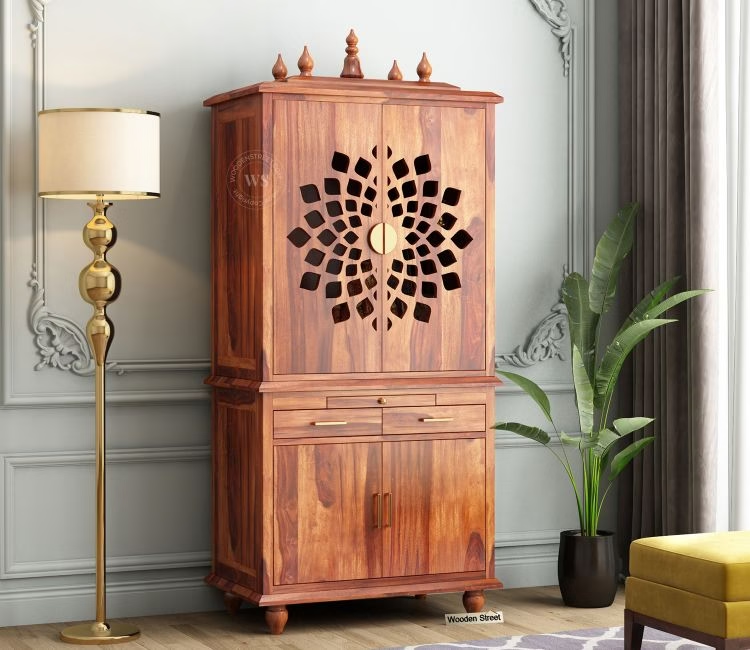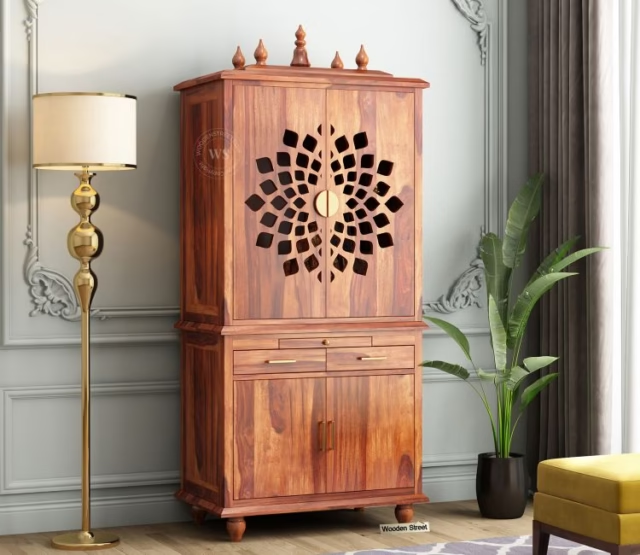Designing a home temple goes beyond aesthetics—it’s about creating a space that radiates peace, positivity, and spiritual energy. In Indian homes, a mandir isn’t merely a décor element; it’s a sacred spot that anchors the home’s emotional and spiritual balance. However, the beauty and serenity of your mandir design truly come alive when it’s placed according to Vastu Shastra—the ancient Indian science of architecture. Whether you prefer a simple mandir design for home, following Vastu guidelines ensures harmony, prosperity, and good vibes flow freely through your space.
Let’s explore the essential Vastu tips and creative placement ideas to help you set up your home temple the right way—blending spiritual tradition with modern design sensibilities.
1. The Ideal Direction for Your Home Temple
According to Vastu Shastra, the northeast (Ishan) corner is the most auspicious direction for setting up a mandir. It’s believed that this corner harnesses maximum divine energy and sunlight, creating a peaceful and pure environment for prayers. If the northeast isn’t possible, the east or north direction is the next best option, as both directions allow natural light to enhance the temple’s aura.
For homeowners living in compact apartments, a wall-mounted mandir design in the northeast corner of the living room or dining area can be a perfect solution. A sleek, floating wooden mandir with minimal carvings not only saves space but also keeps the area clutter-free and spiritually uplifting.
2. Height and Placement: Keeping the Mandir Elevated
Your mandir should always be placed above floor level—preferably on a raised platform or pedestal. The idols or deities should be positioned at eye level when seated, symbolizing reverence and focus during prayer. Avoid placing the mandir directly on the floor, as it’s considered disrespectful in Vastu traditions.
A simple mandir design with a base cabinet offers both elevation and storage for pooja essentials, keeping the area organized and serene. If you’re opting for a stylish modern mandir design, consider using a marble base or a wooden platform with hidden storage drawers for a clean, elegant look.
3. Avoid Bedrooms and Bathrooms Nearby
A temple should never be placed adjacent to a bathroom, below a staircase, or inside a bedroom. Such placements are believed to disrupt the flow of positive energy. If limited space forces you to keep a mandir in your bedroom, ensure that it’s positioned in the northeast corner and separated with a curtain or partition during non-prayer hours.
For studio apartments, a compact wall-mounted mandir design inside a decorative niche or cabinet is a smart way to maintain privacy while ensuring the sanctity of the space.
4. Mandir Material: Choose Natural and Positive Elements
The material of your mandir plays a significant role in the energy it emits. Wooden mandirs—especially those made from Sheesham, Teak, or Mango wood—are considered most auspicious as they represent warmth, naturalness, and strength. Wooden temples bring an earthy charm that suits both traditional and contemporary interiors.
For a modern appeal, marble mandirs are a popular choice. Their pristine white finish radiates peace and purity, perfect for homes seeking a minimalist aesthetic. You can also blend materials—like wood with glass panels or marble with brass accents—for a stylish modern mandir design that feels both divine and designer-approved.
5. Idol Placement and Arrangement
The placement of idols in your home temple requires thoughtful consideration. Always face idols east or west, ensuring the devotee faces the opposite direction during prayer. Avoid overcrowding the mandir with too many deities; ideally, 2–3 idols or framed pictures are sufficient.
According to Vastu, idols should not be taller than 9 inches, and they should not touch the wall directly—leave at least an inch of space behind them to allow energy to circulate freely.
If you’re designing a simple mandir design for home, keep the arrangement uncluttered with a small diya stand, incense holder, and minimal décor to maintain balance and purity.
6. Light, Color, and Ambience
Lighting plays a vital role in enhancing your mandir’s divine presence. Soft, warm lighting—like LED strips behind the idol or concealed spotlights—creates a soothing ambience perfect for meditation and prayer. Diyas or candles add a traditional glow, reinforcing positivity.
When it comes to color, Vastu suggests using serene shades such as white, cream, light yellow, or pastel tones. Avoid dark or bold colors like black or red around the mandir area. For a stylish modern mandir design, consider a light wooden finish with golden accents or backlit panels for an elegant, contemporary touch.
7. Keep the Space Clean and Clutter-Free
Cleanliness is a core principle in Vastu. The temple should always remain spotless and organized. Avoid storing non-religious items in the mandir area. Regularly dust and light incense to maintain freshness.
For convenience, invest in a mandir design with hidden storage drawers or cabinets that allow you to store pooja samagri neatly. A simple mandir design with storage keeps the area clutter-free while maintaining the sacred energy of the space.
8. Integrating Mandir Design into Modern Interiors
Today’s homeowners often look for ways to blend tradition with modern aesthetics. A stylish modern mandir design can seamlessly integrate into your living or dining area without overpowering other elements. Wall-mounted temples with glass shelves, sleek wooden finishes, or marble inlays look stunning in contemporary homes.
If you have a spacious home, a dedicated pooja room can be enhanced with designer jaali partitions, brass bells, or LED lighting for a sophisticated yet spiritual look. For smaller apartments, a corner mandir with geometric wall patterns or floating shelves works beautifully.

9. Avoid Negative Placements
Vastu strongly advises against placing the mandir under a beam, inside the kitchen, or directly facing the main door. These positions can block or disturb the spiritual energy. Similarly, never store heavy or unnecessary objects above or around the temple. Keeping the mandir open and airy allows energy to circulate freely.
10. Personalize Your Divine Space
Lastly, make your temple truly yours. Add fresh flowers, brass diyas, or subtle décor accents that reflect your personality and devotion. A touch of greenery with a small indoor plant nearby can bring freshness and balance. Whether you choose a simple mandir design or a stylish modern mandir design, personalization enhances both beauty and connection.
Conclusion
Placing your home temple the right way is not just about following rules—it’s about creating a sanctuary where peace, devotion, and positivity thrive. With the right mandir design, thoughtful direction, and Vastu-aligned elements, your home can become a haven of spiritual harmony and timeless elegance.
At Wooden Street, you can explore a wide range of simple mandir designs for home and stylish modern mandir designs crafted with precision and devotion. Each piece blends traditional craftsmanship with modern appeal, helping you design a space that’s as beautiful as it is divine.






